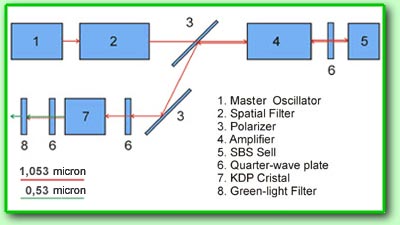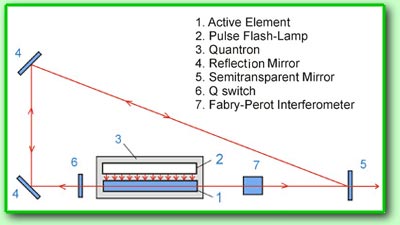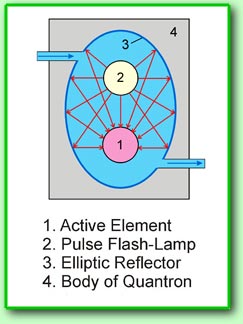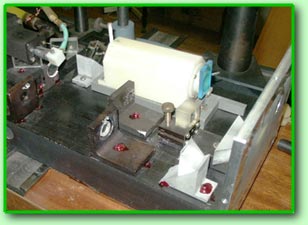|
15. Pulse laser
Pulse
laser is a heart of the pulse holographic setup.
In comparison with gas lasers its structure is much
more complex. The most modern achievements of quantum
electronics are realized in a pulse laser in order
to get a powerful pulse of coherent light of extremely
short duration.  Let us consider a typical
scheme of a pulse laser, see fig. Let us consider a typical
scheme of a pulse laser, see fig.
The master oscillator is the first device in the
line of the light pulse formation. Generation of
the original low-power pulse occurs in it and also
the main pulse parameters - duration, mode composition,
polarization and coherence are set in this oscillator.
The master oscillator has a ring resonator - the
light beam runs by a "circular" trajectory.
In reality its trajectory is more similar to a triangle
in the vertexes of which mirrors are situated,  one of them (the output mirror)
has a small transmission factor, see fig. Active
element is the rod of high-clean monocrystal of
the double fluoride of yttrium-lithium activated
by neodymium (LiYF4:Nd, abbreviation - YLF) is located
in the one resonator arm. one of them (the output mirror)
has a small transmission factor, see fig. Active
element is the rod of high-clean monocrystal of
the double fluoride of yttrium-lithium activated
by neodymium (LiYF4:Nd, abbreviation - YLF) is located
in the one resonator arm.
The rod is located in one of focus of the longitudinal
elliptic reflector, see fig. below. The rod pulse
flash-lamp which serves for pulse pumping the active
element is situated in the second focus. The module
comprising the body, elliptic reflector, flash-lamp
and the laser rod is called a quantron. During pumping the neodymium
ions become excited and go to the higher energetic
levels - inversion population takes place. During pumping the neodymium
ions become excited and go to the higher energetic
levels - inversion population takes place.
For creation of the ultra-short generation pulse
(about 20 ns) the Q-switch modulator - a light shutter
of special construction - is located in the resonator.
It doesn't pass light in an ordinary state. But
when energy density of radiation from the active
element exceeds a certain critical level the shutter
opens abruptly and radiation is "splashing"
into the ring resonator. Conditions of radiation
formation in the master oscillator are such that
the radiation wave length belongs to the infra-red
region and is equal to 1.053 micron. This radiation
is invisible that's why adjustment of the master
oscillator is very complex especially because very
high adjustment accuracy is needed.
One more optical element is located before the output
mirror and its appearance is similar to a simple
glass cube with thoroughly polished faces. In fact
it's a Fabry-Perot interferometer. It selects a
frequency spectrum of the master oscillator and
narrows it to such extent that the radiation coherence
length rises up to several meters.
The beam at the master oscillator output is sufficiently
narrow and isn't fully uniform in its section. In
order to increase uniformity of energy distribution
over the beam section (to remove transversal modes
of higher orders) and to adjust its diameter with
diameter of the amplifier rod the beam passes through
a system of lenses and prisms (spatial filter).
The amplifier construction is analogous to the oscillator
construction. The active element in the form of
the rod of optical glass with addition of neodymium
is also located in the quantron in one of the focuses
of the elliptic reflector. A powerful flash lamp
is located in another focus and this flash-lamp
makes pumping of the active element. The moments
of starting the flash-lamps of the master oscillator
and of the amplifier are strictly synchronized.
Only in this case the light pulse from the oscillator
will be amplified by passing through the active
element of the amplifier. For removal of heat discharged
by the flash-lamps water cooling of quantrons is
used.
When the laser beam passes through the active element
of the amplifier and through the coordinating optical
elements the wave front uniformity is broken because
of aberrations and diffraction effects. In order
to increase uniformity of the beam one more unusual
optical element - the SBS sell (Stimulated Brillouin
Scattering) - a so called cell of the wave front
inversion, is located behind the amplifier as the
reflecting mirror. Its principle of operation is
based on the effects of non-linear optics and is
very complex. The cell reflects the radiation falling
on it as if in antiphase and so the beam non-uniformities
are to a great extent compensated by reverse passing
through the amplifier. As a result of double passing
through the amplifier we obtain a powerful and pure
beam.
For protection of the main oscillator from the reverse
penetration of the amplified laser beam which can
simply destruct a crystal of the main oscillator
a polarizer is set before the amplifier and a quarter-wave
plate is set between the amplifier and the SBS sell.
Polarizer orientated in horizontal plane passes
radiation from the oscillator to the amplifier which
is oriented in the same plane. The quarter-wave
plate turns polarization into circular polarization
and by return pass of the reflected beam polarization
is turned by 90 degrees. Hence the amplified beam
won't pass through the polarizer to the master oscillator
now but will be reflected from it and will come
to the frequency doubler.
 This device is also a "representative"
of non-linear optics working on the basis of the
KDP-crystal (KDP - DihydroPhosphate of Potassium)
and it transforms input radiation into a harmonic
with doubled frequency. At input of the KDP-crystal
radiation has a wave length half as big as the wave
length of original radiation that is 0.53 micron.
This is already a visible green light. For effective
transformation of frequency the quarter-wave plate
is put before the KDP-crystal and this plate transforms
linear polarization of the beam into circular polarization.
One more quarter-wave plate which finally forms
a linearly polarized laser beam is put behind the
KDP-crystal. This device is also a "representative"
of non-linear optics working on the basis of the
KDP-crystal (KDP - DihydroPhosphate of Potassium)
and it transforms input radiation into a harmonic
with doubled frequency. At input of the KDP-crystal
radiation has a wave length half as big as the wave
length of original radiation that is 0.53 micron.
This is already a visible green light. For effective
transformation of frequency the quarter-wave plate
is put before the KDP-crystal and this plate transforms
linear polarization of the beam into circular polarization.
One more quarter-wave plate which finally forms
a linearly polarized laser beam is put behind the
KDP-crystal.
The last optical element of the laser - a light
filter which lets pass only green light and stops
the rests of infra-red light. A fragment of pulse
laser is shown in the photo. You can see lenses
and prisms - elements of the spatial filter. The
module in white body is a thermostat in which the
frequency doubler is situated. The light filter
is fixed on the face plane of the thermostat.
The
pulse laser is characterized not by power (as a
continuous laser) but by pulse energy. Laser of
the described structure can create pulse energy
of 5 Joules and higher. It's a very high energy
which allows to record holograms with dimensions
more than 1x1 m. Energy of 1 Joule is enough for
recording holograms with dimensions of 28x40 cm.
Coherence length of radiation exceeds 2 m. Pulse
duration of 20 ns removes all restrictions relating
to the object rigidity and to the holographic setup
as a whole. With the help of the pulse laser it's
possible to record portraits of people and domestic
animals. You can simply hold objects in your hands
and also record puffs of smoke, drops of water and
so on. Advantages of pulse laser significantly broaden
possibilities for creation of art scenes.
Note:
Author expresses his gratitude to Kornev Alexey
for assistance in writing this lesson.
References
1. O. Svelto, Principles of Lasers, New York, Plenum
Press, 1989.
-->
|





